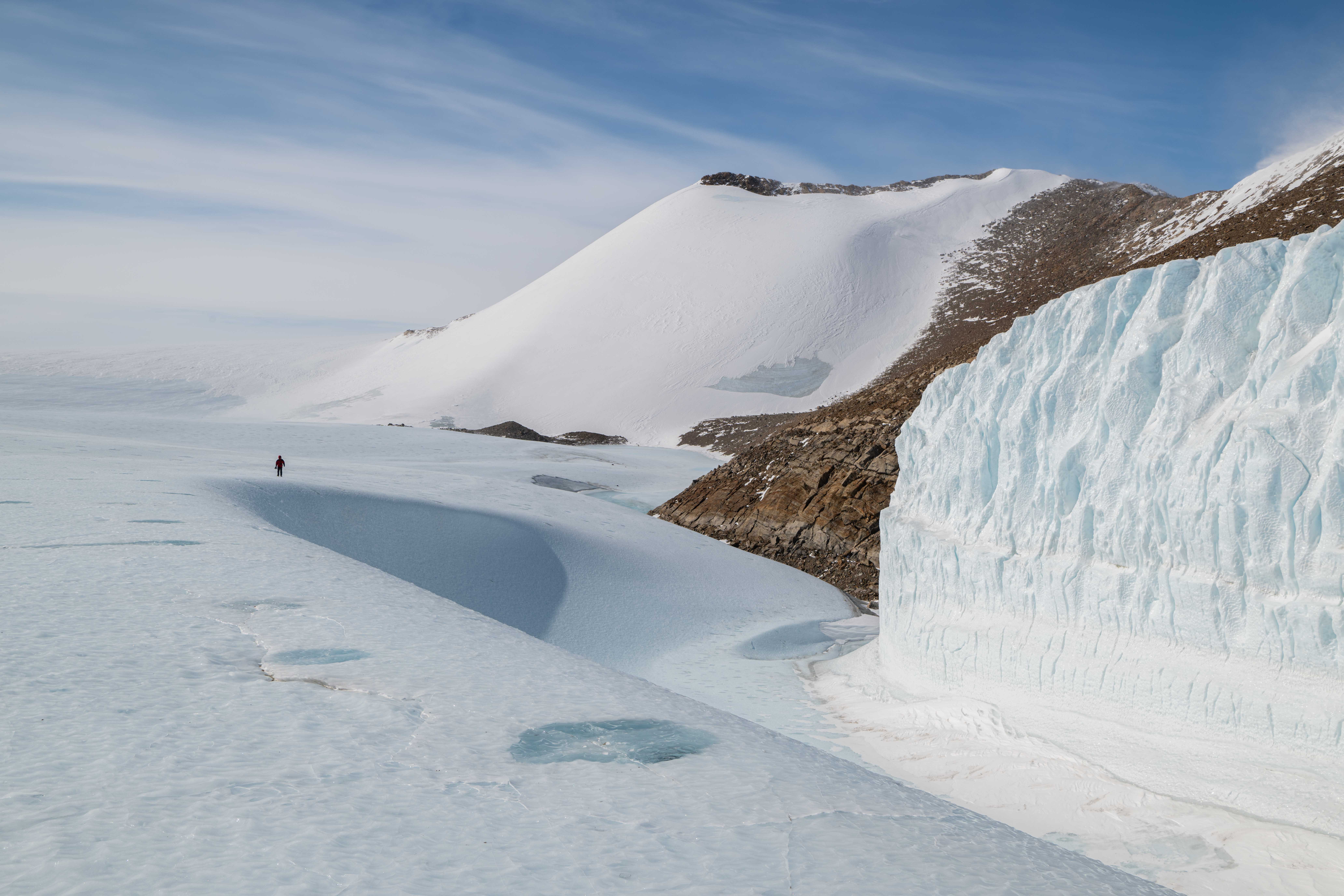Deep Field AnTARCTICA
DEEP FIELD ANTARCTICA

The Ilyushin is an impressive beast. It’s distinctive nose, four engines and bulky profile stand out in contrast to the row of commercial jets at Cape Town International Airport. Most of us pause for a selfie or a snap as we ascend the stairs into the bowels of the beast. Inside it is comfortable but clearly a dual-purpose aircraft on a mission. There are rows of seats for passengers and loads of cargo stowed aft.
An announcement is made approximately an hour before we are due to commence our descent. It’s time to change into our polar clothing. We boarded in Cape Town in temperatures in excess of 20oC and will disembark in temperatures closer to -20oC. There is a sudden burst of activity and plenty of laughter and jokes as we wrestle to don layers of warm gear in our seats.
The excitement builds as we catch glimpses of sea ice and icebergs thousands of feet below. We’re allowed into the glass dome one at a time to stare down at the icy tapestry far below. It’s a breathtaking sight seeing leads in the sea ice far below. I’m afforded the distinct privilege of being allowed to land up front seated next to the navigator. Our landing is unbelievably smooth. We step outside into an alien landscape on a beautiful crisp day ready for adventure.

Our first sortie into the field is an exploratory walk around some frozen lakes and ice features in the Schirmacher Oasis. This is a 16 mile long x 3 mile wide rock plateau dotted with frozen lakes. It is wedged between the vast expanse of continental ice to the south and the Lazarev Ice Shelf to the north.
The Schirmacher Oasis is home to two scientific bases, Novolazarevskaya (Russian Federation) and Maitri (India). It’s also home to the recently renovated and very comfortable Oasis Camp, our base for tourism operations.


Our first excursion by air is to the Gruber Mountains via a stunning one hour flight to the east in the ever-reliable Twin Otter. Two of our team are very experienced alpinists and are tasked with climbing Mt Ritscher. This peak affords incredible views in all directions.
While the climbers ascend the rest of the team fly to nearby Lake Untersee to visit Dale Andersen’s team and reunite a scientist with her team.
Beneath the frozen lake are three billion year old stromatolites which hold clues to the origins of life on earth. The environment is also an excellent analog for Mars and the outer moons of Jupiter and Saturn. Finding life in Lake Untersee may hold clues to how to find life in similar conditions far from earth. It was fascinating to hear from Dale about his team’s research and explore the lake.
The surrounding hills are home to thousands of nesting Snow Petrels, while the lake hosts huge boulders migrating slowly across the permanently frozen surface.
We return in our Twin Otter to collect the skiers who have successfully summited Mt Ritscher, and ascend to enjoy the incredible scenery on the flight back to Novo airstrip. Our skilled pilots dip the wing and make loops so everyone could witness and capture the beauty below. You can read a little more about Lake Untersee here.


In the following days we visit two Emperor Penguin colonies. The Astrid colony on the edge of the Nivl Ice Shelf and the Ragnhild colony at Crown Bay to the east. Both colonies were recently discovered through analysis of satellite images. On both occasions our expert pilots find suitable locations to land away from the colonies taking care to adhere to IAATO guidelines for approaching Emperor Penguin colonies.
Prior to visiting the colonies we obtained a permit to fly a drone to capture aerial images to obtain the first accurate colony counts. This coming November we aim to return to the Astrid colony and obtain more images to enable us to compare counts between 2023 and 2024. We are hopeful that we may also be able to visit the previously unvisited Lazarev colony to obtain images for an accurate population estimate for that colony.

Just watching these magnificent birds on the ice is one of the greatest spectacles in nature and an absolute dream for photographers. There’s no doubt Emperor Penguin chicks in their ‘Biggles Suits’ are the most adorable animals on earth.



Our final major objective was to scout landing and camping sites in the Fenriskjeften Mountains. These awe inspiring peaks take their names from Norse mythology. We flew late afternoon on a calm day and spent a few glorious hours basking in the incredible views and the eerie, but mesmerising, sound of silence atop the Fenristunga (Wolf’s Tongue) glacier. This sits to the west of iconic Ulvetanna and Holtanna mountains.
Ulvetanna’s north face rises over 4500 feet and Holtanna’s incredible west face is a sight to behold. On the return flight our pilots weaved their magic once again, affording us incredible views of the mountains as the sun cast shadows miles across the ice. Another dream day in Antarctica.
One enduring memory from this trip is the re-discovery of the romance of flight. Flying on commercial airliners has become a dreary experience. By contrast every flight in Antarctica was an extraordinary, mind-blowing, ethereal privilege.

Even on the days we didn’t fly there were so many exceptionally beautiful places to visit and explore including: an incredible neon blue ice tunnel in the Lazarev Ice Shelf; and a huge ice wall 45 minutes drive to the east of the Schirmacher Oasis.
Without exception everyone was left feeling exceptionally privileged to have experienced this incredibly beautiful and remote part of Antarctica. We can’t wait to share this experience with 7 guests in November 2024.



